Health Literacy and Communication
VerifiedAdded on 2021/05/31
|9
|2371
|31
AI Summary
Contribute Materials
Your contribution can guide someone’s learning journey. Share your
documents today.
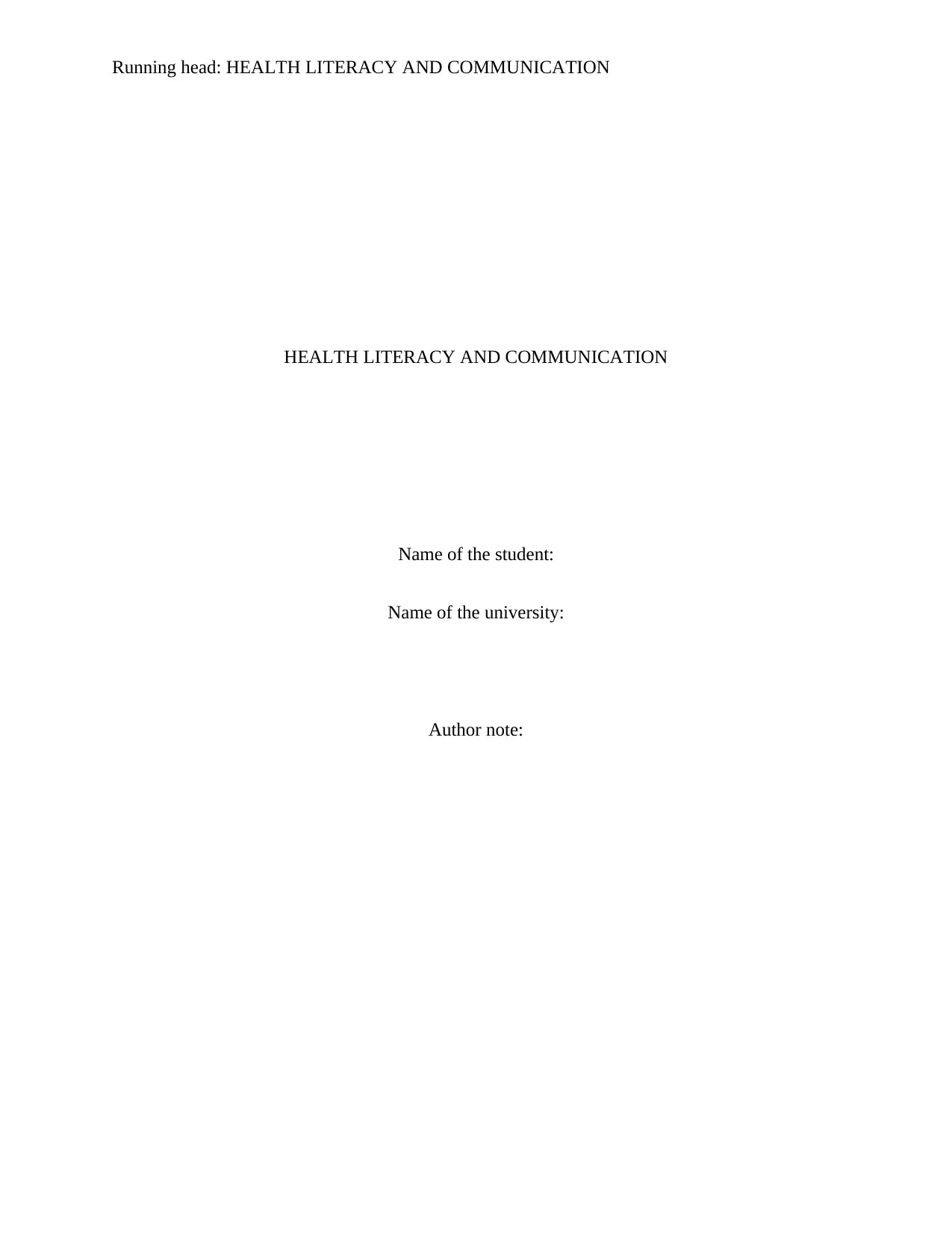
Running head: HEALTH LITERACY AND COMMUNICATION
HEALTH LITERACY AND COMMUNICATION
Name of the student:
Name of the university:
Author note:
HEALTH LITERACY AND COMMUNICATION
Name of the student:
Name of the university:
Author note:
Secure Best Marks with AI Grader
Need help grading? Try our AI Grader for instant feedback on your assignments.
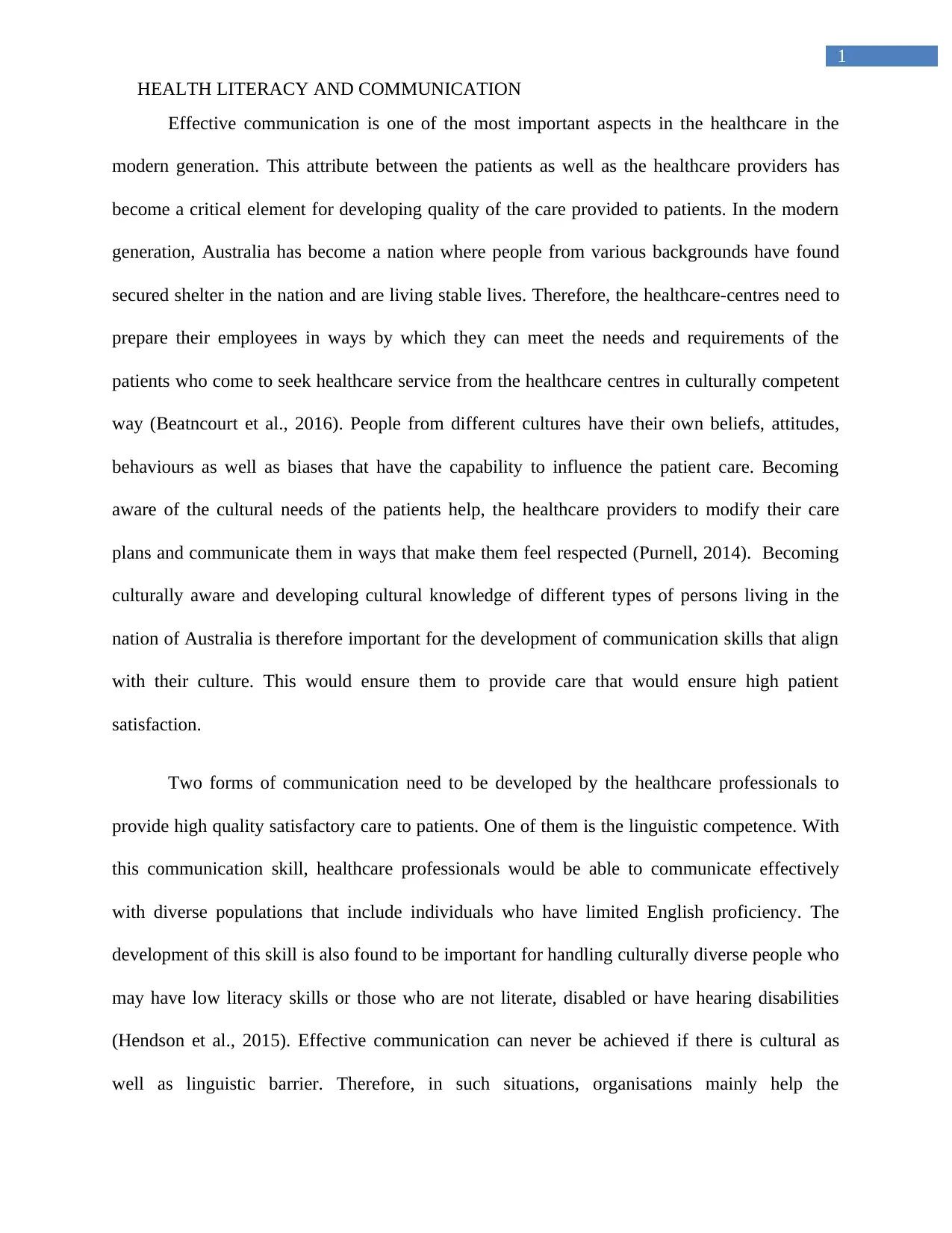
1
HEALTH LITERACY AND COMMUNICATION
Effective communication is one of the most important aspects in the healthcare in the
modern generation. This attribute between the patients as well as the healthcare providers has
become a critical element for developing quality of the care provided to patients. In the modern
generation, Australia has become a nation where people from various backgrounds have found
secured shelter in the nation and are living stable lives. Therefore, the healthcare-centres need to
prepare their employees in ways by which they can meet the needs and requirements of the
patients who come to seek healthcare service from the healthcare centres in culturally competent
way (Beatncourt et al., 2016). People from different cultures have their own beliefs, attitudes,
behaviours as well as biases that have the capability to influence the patient care. Becoming
aware of the cultural needs of the patients help, the healthcare providers to modify their care
plans and communicate them in ways that make them feel respected (Purnell, 2014). Becoming
culturally aware and developing cultural knowledge of different types of persons living in the
nation of Australia is therefore important for the development of communication skills that align
with their culture. This would ensure them to provide care that would ensure high patient
satisfaction.
Two forms of communication need to be developed by the healthcare professionals to
provide high quality satisfactory care to patients. One of them is the linguistic competence. With
this communication skill, healthcare professionals would be able to communicate effectively
with diverse populations that include individuals who have limited English proficiency. The
development of this skill is also found to be important for handling culturally diverse people who
may have low literacy skills or those who are not literate, disabled or have hearing disabilities
(Hendson et al., 2015). Effective communication can never be achieved if there is cultural as
well as linguistic barrier. Therefore, in such situations, organisations mainly help the
HEALTH LITERACY AND COMMUNICATION
Effective communication is one of the most important aspects in the healthcare in the
modern generation. This attribute between the patients as well as the healthcare providers has
become a critical element for developing quality of the care provided to patients. In the modern
generation, Australia has become a nation where people from various backgrounds have found
secured shelter in the nation and are living stable lives. Therefore, the healthcare-centres need to
prepare their employees in ways by which they can meet the needs and requirements of the
patients who come to seek healthcare service from the healthcare centres in culturally competent
way (Beatncourt et al., 2016). People from different cultures have their own beliefs, attitudes,
behaviours as well as biases that have the capability to influence the patient care. Becoming
aware of the cultural needs of the patients help, the healthcare providers to modify their care
plans and communicate them in ways that make them feel respected (Purnell, 2014). Becoming
culturally aware and developing cultural knowledge of different types of persons living in the
nation of Australia is therefore important for the development of communication skills that align
with their culture. This would ensure them to provide care that would ensure high patient
satisfaction.
Two forms of communication need to be developed by the healthcare professionals to
provide high quality satisfactory care to patients. One of them is the linguistic competence. With
this communication skill, healthcare professionals would be able to communicate effectively
with diverse populations that include individuals who have limited English proficiency. The
development of this skill is also found to be important for handling culturally diverse people who
may have low literacy skills or those who are not literate, disabled or have hearing disabilities
(Hendson et al., 2015). Effective communication can never be achieved if there is cultural as
well as linguistic barrier. Therefore, in such situations, organisations mainly help the
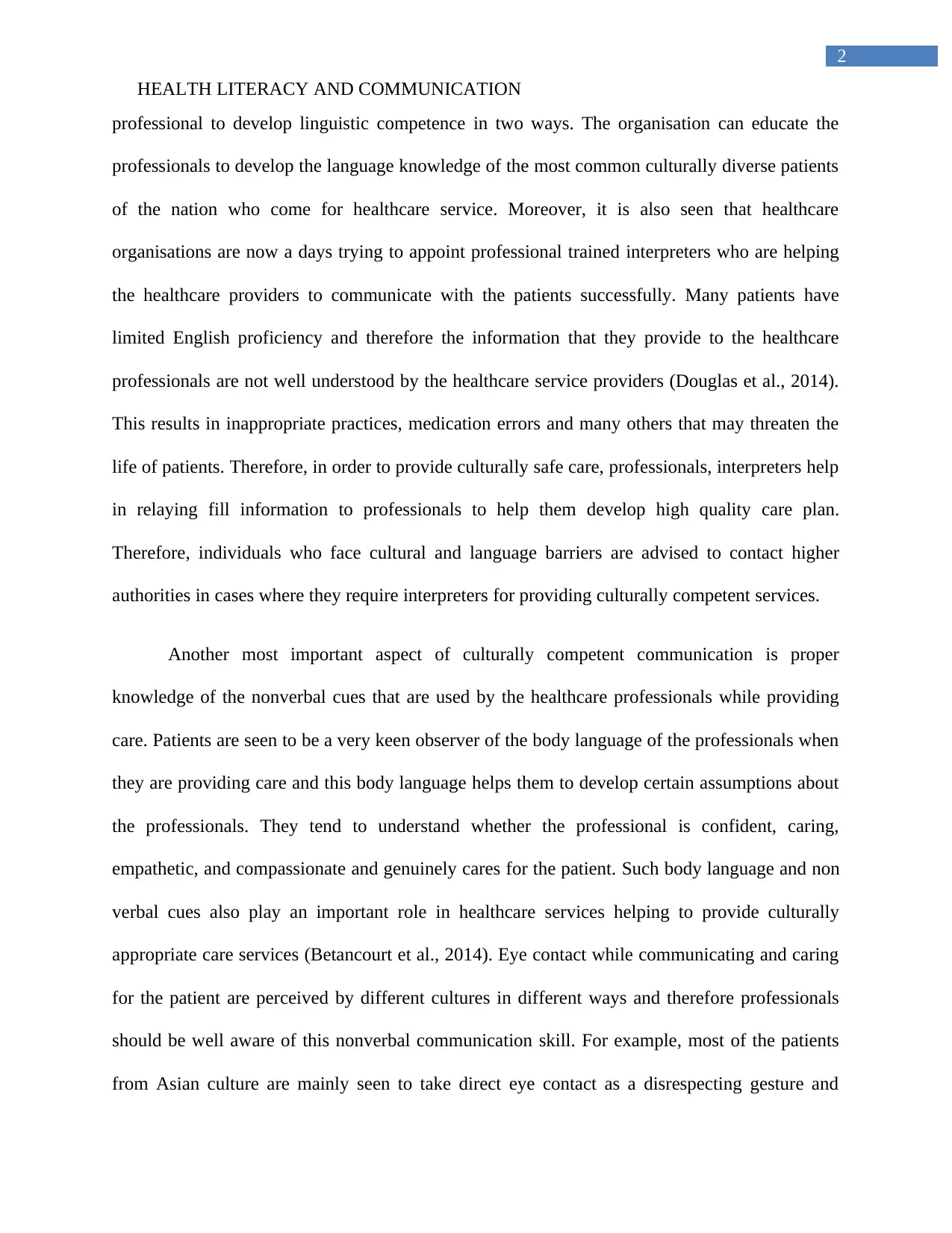
2
HEALTH LITERACY AND COMMUNICATION
professional to develop linguistic competence in two ways. The organisation can educate the
professionals to develop the language knowledge of the most common culturally diverse patients
of the nation who come for healthcare service. Moreover, it is also seen that healthcare
organisations are now a days trying to appoint professional trained interpreters who are helping
the healthcare providers to communicate with the patients successfully. Many patients have
limited English proficiency and therefore the information that they provide to the healthcare
professionals are not well understood by the healthcare service providers (Douglas et al., 2014).
This results in inappropriate practices, medication errors and many others that may threaten the
life of patients. Therefore, in order to provide culturally safe care, professionals, interpreters help
in relaying fill information to professionals to help them develop high quality care plan.
Therefore, individuals who face cultural and language barriers are advised to contact higher
authorities in cases where they require interpreters for providing culturally competent services.
Another most important aspect of culturally competent communication is proper
knowledge of the nonverbal cues that are used by the healthcare professionals while providing
care. Patients are seen to be a very keen observer of the body language of the professionals when
they are providing care and this body language helps them to develop certain assumptions about
the professionals. They tend to understand whether the professional is confident, caring,
empathetic, and compassionate and genuinely cares for the patient. Such body language and non
verbal cues also play an important role in healthcare services helping to provide culturally
appropriate care services (Betancourt et al., 2014). Eye contact while communicating and caring
for the patient are perceived by different cultures in different ways and therefore professionals
should be well aware of this nonverbal communication skill. For example, most of the patients
from Asian culture are mainly seen to take direct eye contact as a disrespecting gesture and
HEALTH LITERACY AND COMMUNICATION
professional to develop linguistic competence in two ways. The organisation can educate the
professionals to develop the language knowledge of the most common culturally diverse patients
of the nation who come for healthcare service. Moreover, it is also seen that healthcare
organisations are now a days trying to appoint professional trained interpreters who are helping
the healthcare providers to communicate with the patients successfully. Many patients have
limited English proficiency and therefore the information that they provide to the healthcare
professionals are not well understood by the healthcare service providers (Douglas et al., 2014).
This results in inappropriate practices, medication errors and many others that may threaten the
life of patients. Therefore, in order to provide culturally safe care, professionals, interpreters help
in relaying fill information to professionals to help them develop high quality care plan.
Therefore, individuals who face cultural and language barriers are advised to contact higher
authorities in cases where they require interpreters for providing culturally competent services.
Another most important aspect of culturally competent communication is proper
knowledge of the nonverbal cues that are used by the healthcare professionals while providing
care. Patients are seen to be a very keen observer of the body language of the professionals when
they are providing care and this body language helps them to develop certain assumptions about
the professionals. They tend to understand whether the professional is confident, caring,
empathetic, and compassionate and genuinely cares for the patient. Such body language and non
verbal cues also play an important role in healthcare services helping to provide culturally
appropriate care services (Betancourt et al., 2014). Eye contact while communicating and caring
for the patient are perceived by different cultures in different ways and therefore professionals
should be well aware of this nonverbal communication skill. For example, most of the patients
from Asian culture are mainly seen to take direct eye contact as a disrespecting gesture and
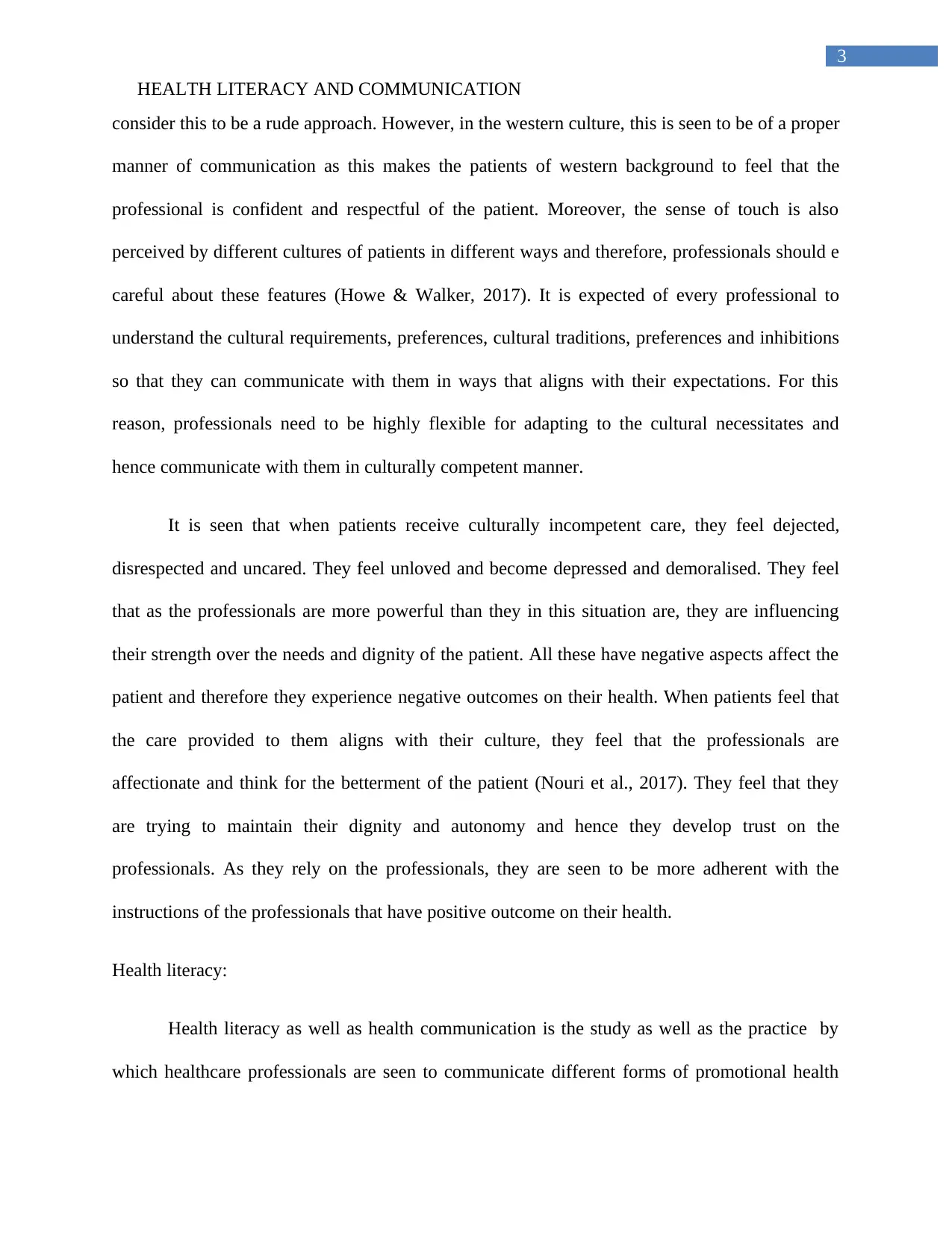
3
HEALTH LITERACY AND COMMUNICATION
consider this to be a rude approach. However, in the western culture, this is seen to be of a proper
manner of communication as this makes the patients of western background to feel that the
professional is confident and respectful of the patient. Moreover, the sense of touch is also
perceived by different cultures of patients in different ways and therefore, professionals should e
careful about these features (Howe & Walker, 2017). It is expected of every professional to
understand the cultural requirements, preferences, cultural traditions, preferences and inhibitions
so that they can communicate with them in ways that aligns with their expectations. For this
reason, professionals need to be highly flexible for adapting to the cultural necessitates and
hence communicate with them in culturally competent manner.
It is seen that when patients receive culturally incompetent care, they feel dejected,
disrespected and uncared. They feel unloved and become depressed and demoralised. They feel
that as the professionals are more powerful than they in this situation are, they are influencing
their strength over the needs and dignity of the patient. All these have negative aspects affect the
patient and therefore they experience negative outcomes on their health. When patients feel that
the care provided to them aligns with their culture, they feel that the professionals are
affectionate and think for the betterment of the patient (Nouri et al., 2017). They feel that they
are trying to maintain their dignity and autonomy and hence they develop trust on the
professionals. As they rely on the professionals, they are seen to be more adherent with the
instructions of the professionals that have positive outcome on their health.
Health literacy:
Health literacy as well as health communication is the study as well as the practice by
which healthcare professionals are seen to communicate different forms of promotional health
HEALTH LITERACY AND COMMUNICATION
consider this to be a rude approach. However, in the western culture, this is seen to be of a proper
manner of communication as this makes the patients of western background to feel that the
professional is confident and respectful of the patient. Moreover, the sense of touch is also
perceived by different cultures of patients in different ways and therefore, professionals should e
careful about these features (Howe & Walker, 2017). It is expected of every professional to
understand the cultural requirements, preferences, cultural traditions, preferences and inhibitions
so that they can communicate with them in ways that aligns with their expectations. For this
reason, professionals need to be highly flexible for adapting to the cultural necessitates and
hence communicate with them in culturally competent manner.
It is seen that when patients receive culturally incompetent care, they feel dejected,
disrespected and uncared. They feel unloved and become depressed and demoralised. They feel
that as the professionals are more powerful than they in this situation are, they are influencing
their strength over the needs and dignity of the patient. All these have negative aspects affect the
patient and therefore they experience negative outcomes on their health. When patients feel that
the care provided to them aligns with their culture, they feel that the professionals are
affectionate and think for the betterment of the patient (Nouri et al., 2017). They feel that they
are trying to maintain their dignity and autonomy and hence they develop trust on the
professionals. As they rely on the professionals, they are seen to be more adherent with the
instructions of the professionals that have positive outcome on their health.
Health literacy:
Health literacy as well as health communication is the study as well as the practice by
which healthcare professionals are seen to communicate different forms of promotional health
Secure Best Marks with AI Grader
Need help grading? Try our AI Grader for instant feedback on your assignments.
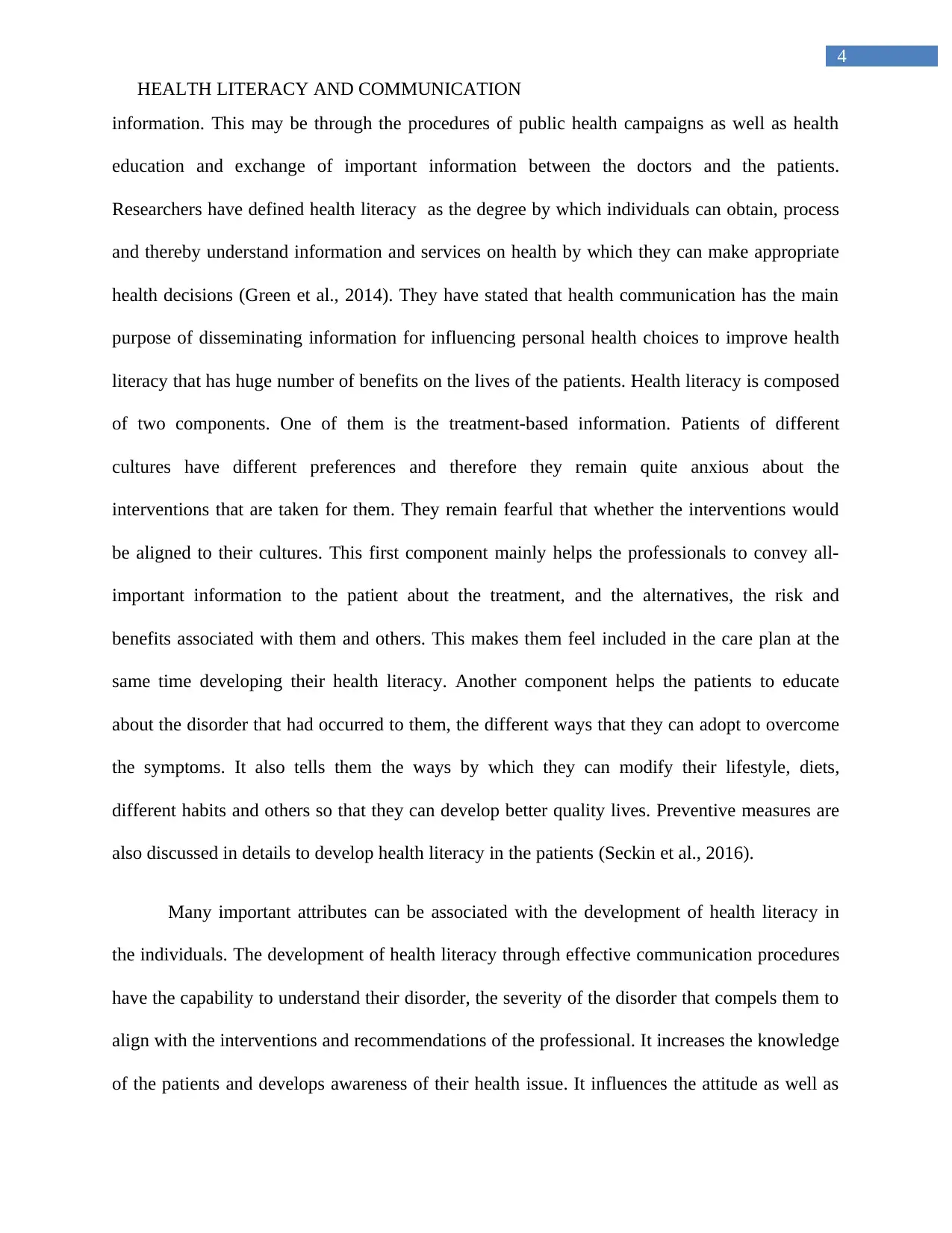
4
HEALTH LITERACY AND COMMUNICATION
information. This may be through the procedures of public health campaigns as well as health
education and exchange of important information between the doctors and the patients.
Researchers have defined health literacy as the degree by which individuals can obtain, process
and thereby understand information and services on health by which they can make appropriate
health decisions (Green et al., 2014). They have stated that health communication has the main
purpose of disseminating information for influencing personal health choices to improve health
literacy that has huge number of benefits on the lives of the patients. Health literacy is composed
of two components. One of them is the treatment-based information. Patients of different
cultures have different preferences and therefore they remain quite anxious about the
interventions that are taken for them. They remain fearful that whether the interventions would
be aligned to their cultures. This first component mainly helps the professionals to convey all-
important information to the patient about the treatment, and the alternatives, the risk and
benefits associated with them and others. This makes them feel included in the care plan at the
same time developing their health literacy. Another component helps the patients to educate
about the disorder that had occurred to them, the different ways that they can adopt to overcome
the symptoms. It also tells them the ways by which they can modify their lifestyle, diets,
different habits and others so that they can develop better quality lives. Preventive measures are
also discussed in details to develop health literacy in the patients (Seckin et al., 2016).
Many important attributes can be associated with the development of health literacy in
the individuals. The development of health literacy through effective communication procedures
have the capability to understand their disorder, the severity of the disorder that compels them to
align with the interventions and recommendations of the professional. It increases the knowledge
of the patients and develops awareness of their health issue. It influences the attitude as well as
HEALTH LITERACY AND COMMUNICATION
information. This may be through the procedures of public health campaigns as well as health
education and exchange of important information between the doctors and the patients.
Researchers have defined health literacy as the degree by which individuals can obtain, process
and thereby understand information and services on health by which they can make appropriate
health decisions (Green et al., 2014). They have stated that health communication has the main
purpose of disseminating information for influencing personal health choices to improve health
literacy that has huge number of benefits on the lives of the patients. Health literacy is composed
of two components. One of them is the treatment-based information. Patients of different
cultures have different preferences and therefore they remain quite anxious about the
interventions that are taken for them. They remain fearful that whether the interventions would
be aligned to their cultures. This first component mainly helps the professionals to convey all-
important information to the patient about the treatment, and the alternatives, the risk and
benefits associated with them and others. This makes them feel included in the care plan at the
same time developing their health literacy. Another component helps the patients to educate
about the disorder that had occurred to them, the different ways that they can adopt to overcome
the symptoms. It also tells them the ways by which they can modify their lifestyle, diets,
different habits and others so that they can develop better quality lives. Preventive measures are
also discussed in details to develop health literacy in the patients (Seckin et al., 2016).
Many important attributes can be associated with the development of health literacy in
the individuals. The development of health literacy through effective communication procedures
have the capability to understand their disorder, the severity of the disorder that compels them to
align with the interventions and recommendations of the professional. It increases the knowledge
of the patients and develops awareness of their health issue. It influences the attitude as well as
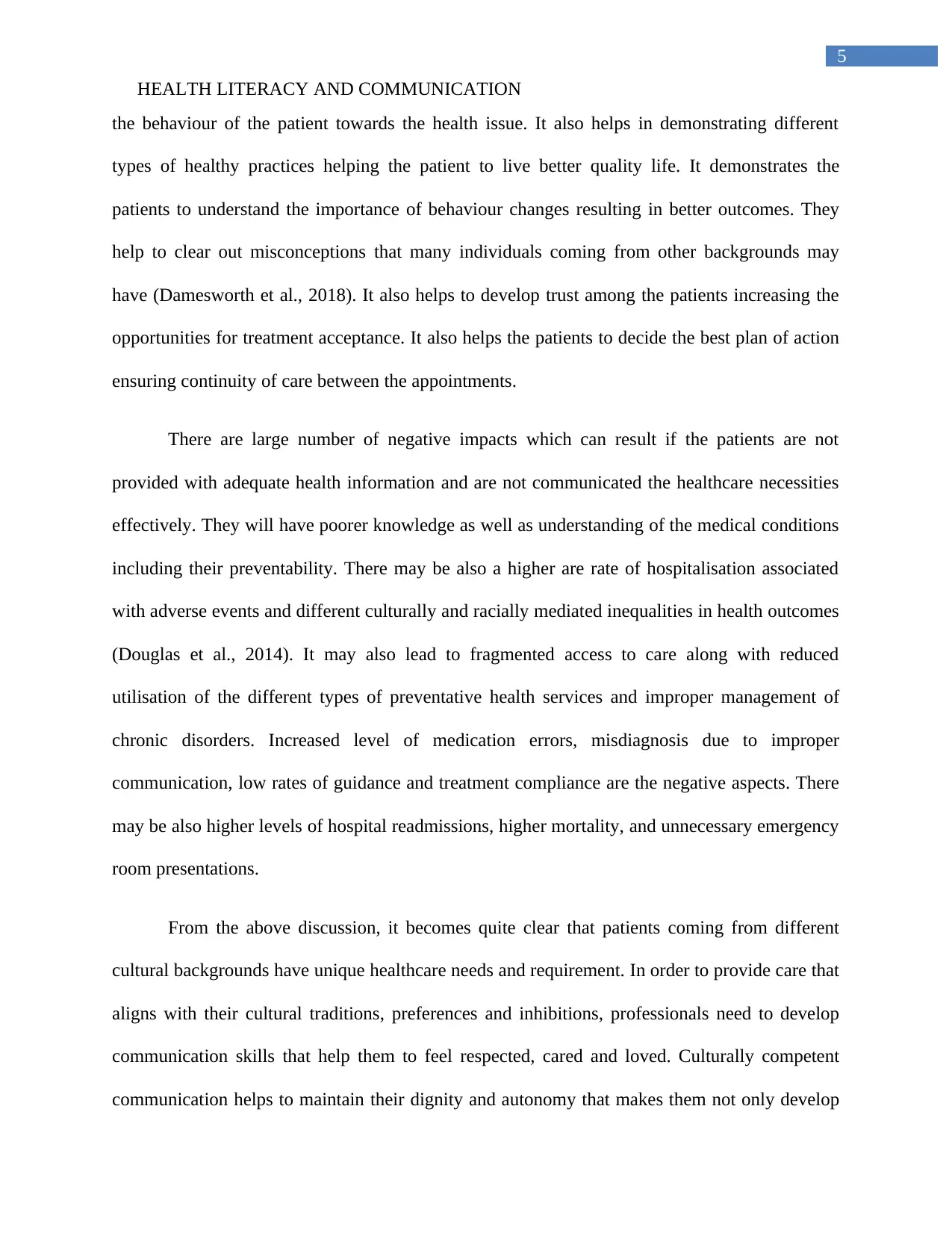
5
HEALTH LITERACY AND COMMUNICATION
the behaviour of the patient towards the health issue. It also helps in demonstrating different
types of healthy practices helping the patient to live better quality life. It demonstrates the
patients to understand the importance of behaviour changes resulting in better outcomes. They
help to clear out misconceptions that many individuals coming from other backgrounds may
have (Damesworth et al., 2018). It also helps to develop trust among the patients increasing the
opportunities for treatment acceptance. It also helps the patients to decide the best plan of action
ensuring continuity of care between the appointments.
There are large number of negative impacts which can result if the patients are not
provided with adequate health information and are not communicated the healthcare necessities
effectively. They will have poorer knowledge as well as understanding of the medical conditions
including their preventability. There may be also a higher are rate of hospitalisation associated
with adverse events and different culturally and racially mediated inequalities in health outcomes
(Douglas et al., 2014). It may also lead to fragmented access to care along with reduced
utilisation of the different types of preventative health services and improper management of
chronic disorders. Increased level of medication errors, misdiagnosis due to improper
communication, low rates of guidance and treatment compliance are the negative aspects. There
may be also higher levels of hospital readmissions, higher mortality, and unnecessary emergency
room presentations.
From the above discussion, it becomes quite clear that patients coming from different
cultural backgrounds have unique healthcare needs and requirement. In order to provide care that
aligns with their cultural traditions, preferences and inhibitions, professionals need to develop
communication skills that help them to feel respected, cared and loved. Culturally competent
communication helps to maintain their dignity and autonomy that makes them not only develop
HEALTH LITERACY AND COMMUNICATION
the behaviour of the patient towards the health issue. It also helps in demonstrating different
types of healthy practices helping the patient to live better quality life. It demonstrates the
patients to understand the importance of behaviour changes resulting in better outcomes. They
help to clear out misconceptions that many individuals coming from other backgrounds may
have (Damesworth et al., 2018). It also helps to develop trust among the patients increasing the
opportunities for treatment acceptance. It also helps the patients to decide the best plan of action
ensuring continuity of care between the appointments.
There are large number of negative impacts which can result if the patients are not
provided with adequate health information and are not communicated the healthcare necessities
effectively. They will have poorer knowledge as well as understanding of the medical conditions
including their preventability. There may be also a higher are rate of hospitalisation associated
with adverse events and different culturally and racially mediated inequalities in health outcomes
(Douglas et al., 2014). It may also lead to fragmented access to care along with reduced
utilisation of the different types of preventative health services and improper management of
chronic disorders. Increased level of medication errors, misdiagnosis due to improper
communication, low rates of guidance and treatment compliance are the negative aspects. There
may be also higher levels of hospital readmissions, higher mortality, and unnecessary emergency
room presentations.
From the above discussion, it becomes quite clear that patients coming from different
cultural backgrounds have unique healthcare needs and requirement. In order to provide care that
aligns with their cultural traditions, preferences and inhibitions, professionals need to develop
communication skills that help them to feel respected, cared and loved. Culturally competent
communication helps to maintain their dignity and autonomy that makes them not only develop
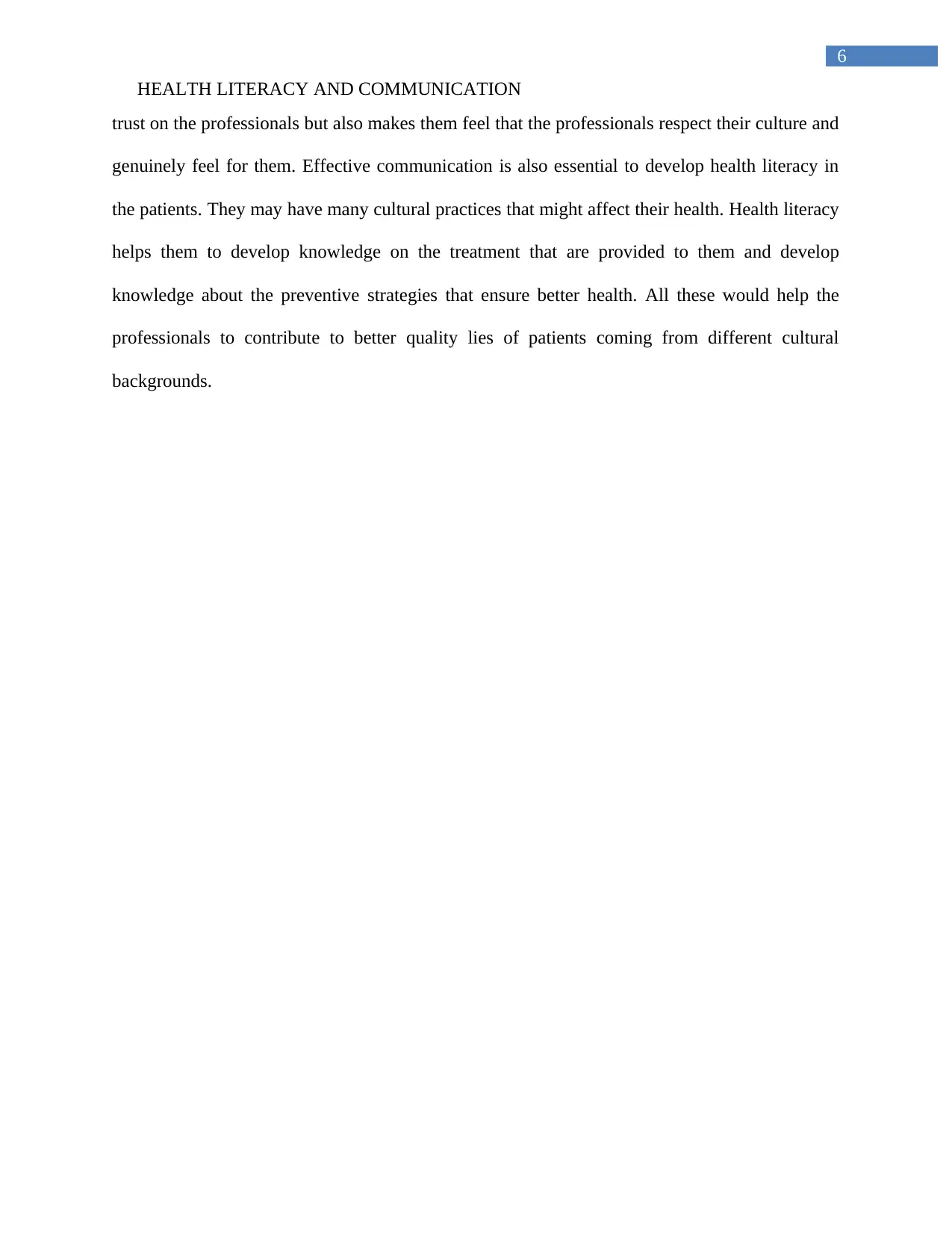
6
HEALTH LITERACY AND COMMUNICATION
trust on the professionals but also makes them feel that the professionals respect their culture and
genuinely feel for them. Effective communication is also essential to develop health literacy in
the patients. They may have many cultural practices that might affect their health. Health literacy
helps them to develop knowledge on the treatment that are provided to them and develop
knowledge about the preventive strategies that ensure better health. All these would help the
professionals to contribute to better quality lies of patients coming from different cultural
backgrounds.
HEALTH LITERACY AND COMMUNICATION
trust on the professionals but also makes them feel that the professionals respect their culture and
genuinely feel for them. Effective communication is also essential to develop health literacy in
the patients. They may have many cultural practices that might affect their health. Health literacy
helps them to develop knowledge on the treatment that are provided to them and develop
knowledge about the preventive strategies that ensure better health. All these would help the
professionals to contribute to better quality lies of patients coming from different cultural
backgrounds.
Paraphrase This Document
Need a fresh take? Get an instant paraphrase of this document with our AI Paraphraser
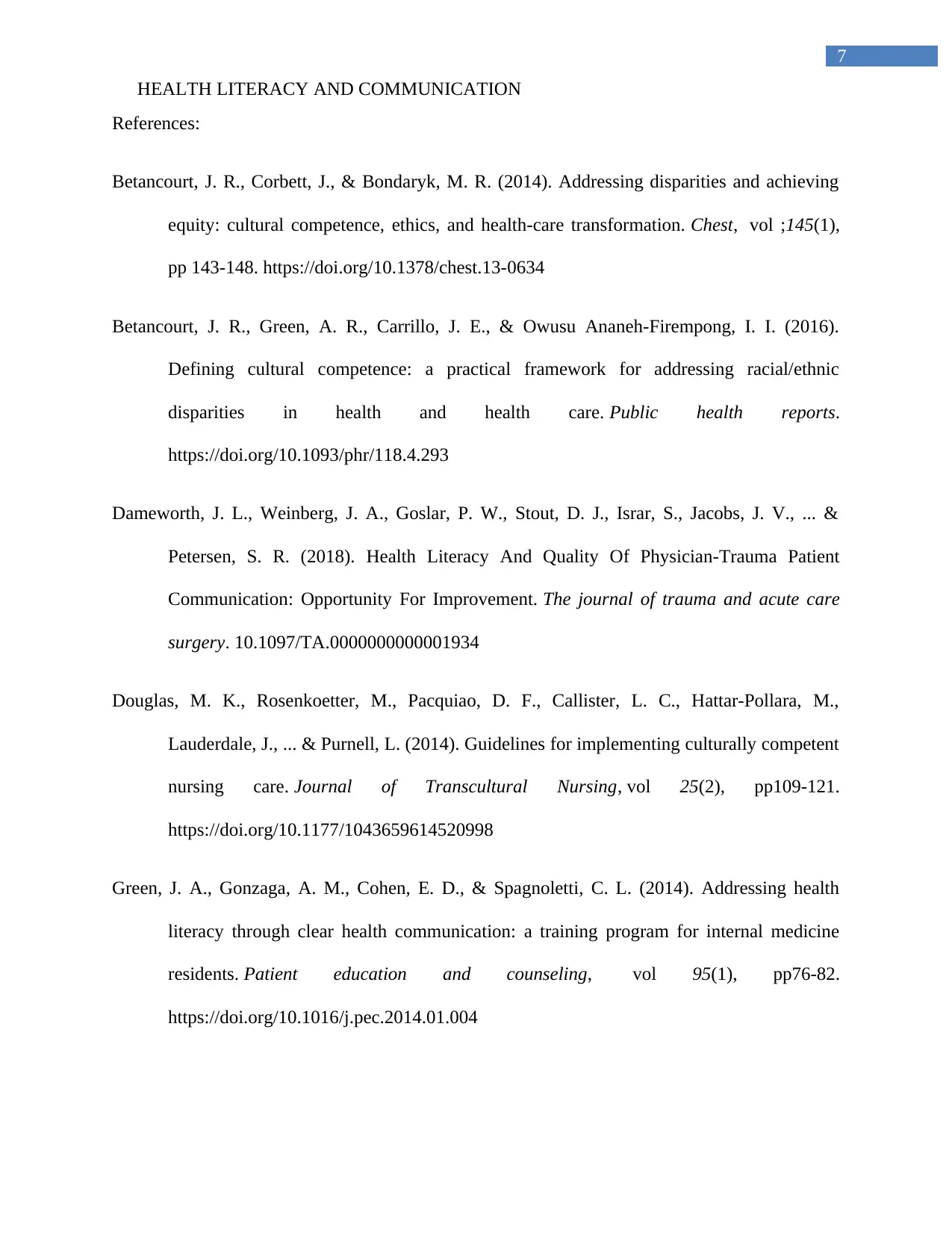
7
HEALTH LITERACY AND COMMUNICATION
References:
Betancourt, J. R., Corbett, J., & Bondaryk, M. R. (2014). Addressing disparities and achieving
equity: cultural competence, ethics, and health-care transformation. Chest, vol ;145(1),
pp 143-148. https://doi.org/10.1378/chest.13-0634
Betancourt, J. R., Green, A. R., Carrillo, J. E., & Owusu Ananeh-Firempong, I. I. (2016).
Defining cultural competence: a practical framework for addressing racial/ethnic
disparities in health and health care. Public health reports.
https://doi.org/10.1093/phr/118.4.293
Dameworth, J. L., Weinberg, J. A., Goslar, P. W., Stout, D. J., Israr, S., Jacobs, J. V., ... &
Petersen, S. R. (2018). Health Literacy And Quality Of Physician-Trauma Patient
Communication: Opportunity For Improvement. The journal of trauma and acute care
surgery. 10.1097/TA.0000000000001934
Douglas, M. K., Rosenkoetter, M., Pacquiao, D. F., Callister, L. C., Hattar-Pollara, M.,
Lauderdale, J., ... & Purnell, L. (2014). Guidelines for implementing culturally competent
nursing care. Journal of Transcultural Nursing, vol 25(2), pp109-121.
https://doi.org/10.1177/1043659614520998
Green, J. A., Gonzaga, A. M., Cohen, E. D., & Spagnoletti, C. L. (2014). Addressing health
literacy through clear health communication: a training program for internal medicine
residents. Patient education and counseling, vol 95(1), pp76-82.
https://doi.org/10.1016/j.pec.2014.01.004
HEALTH LITERACY AND COMMUNICATION
References:
Betancourt, J. R., Corbett, J., & Bondaryk, M. R. (2014). Addressing disparities and achieving
equity: cultural competence, ethics, and health-care transformation. Chest, vol ;145(1),
pp 143-148. https://doi.org/10.1378/chest.13-0634
Betancourt, J. R., Green, A. R., Carrillo, J. E., & Owusu Ananeh-Firempong, I. I. (2016).
Defining cultural competence: a practical framework for addressing racial/ethnic
disparities in health and health care. Public health reports.
https://doi.org/10.1093/phr/118.4.293
Dameworth, J. L., Weinberg, J. A., Goslar, P. W., Stout, D. J., Israr, S., Jacobs, J. V., ... &
Petersen, S. R. (2018). Health Literacy And Quality Of Physician-Trauma Patient
Communication: Opportunity For Improvement. The journal of trauma and acute care
surgery. 10.1097/TA.0000000000001934
Douglas, M. K., Rosenkoetter, M., Pacquiao, D. F., Callister, L. C., Hattar-Pollara, M.,
Lauderdale, J., ... & Purnell, L. (2014). Guidelines for implementing culturally competent
nursing care. Journal of Transcultural Nursing, vol 25(2), pp109-121.
https://doi.org/10.1177/1043659614520998
Green, J. A., Gonzaga, A. M., Cohen, E. D., & Spagnoletti, C. L. (2014). Addressing health
literacy through clear health communication: a training program for internal medicine
residents. Patient education and counseling, vol 95(1), pp76-82.
https://doi.org/10.1016/j.pec.2014.01.004
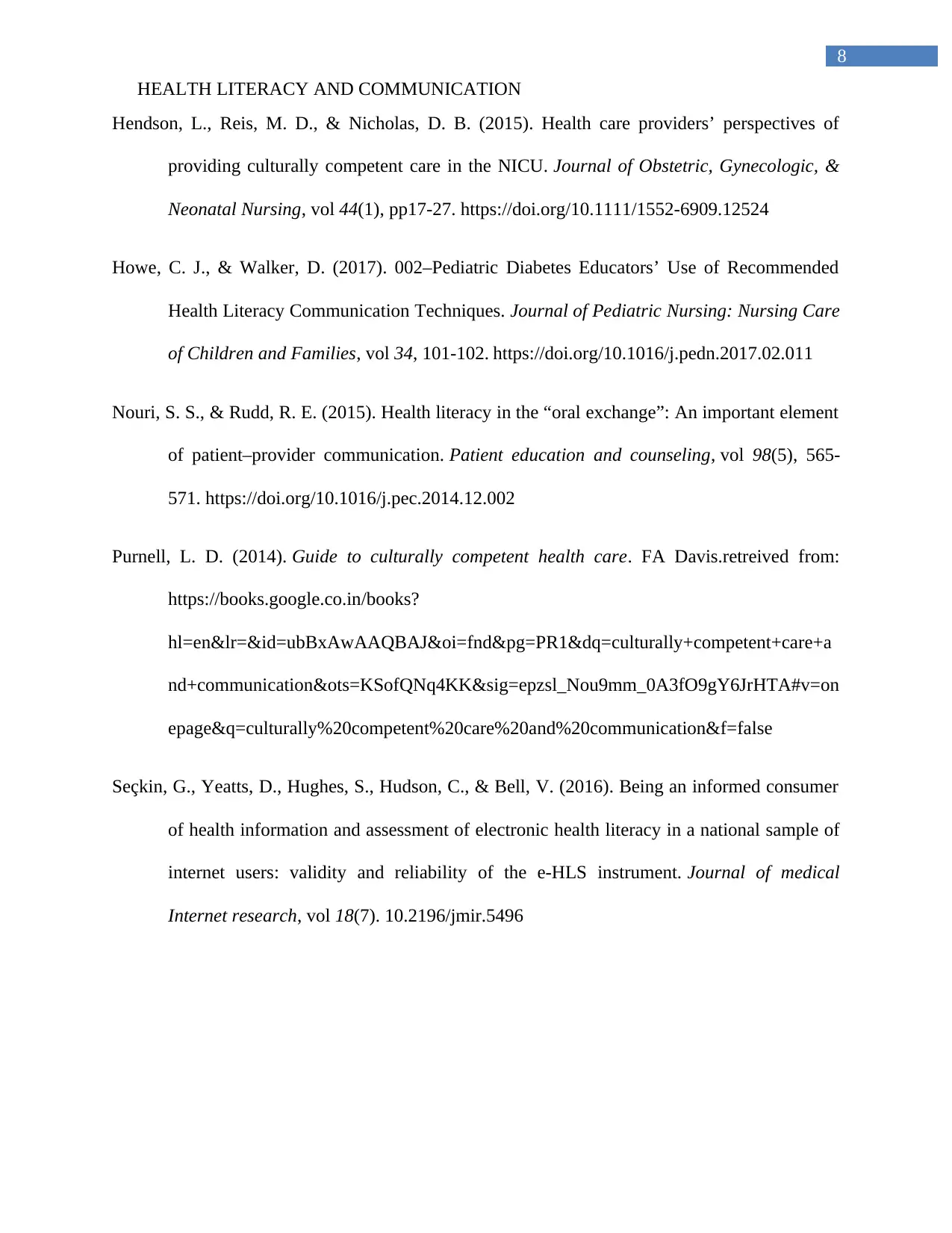
8
HEALTH LITERACY AND COMMUNICATION
Hendson, L., Reis, M. D., & Nicholas, D. B. (2015). Health care providers’ perspectives of
providing culturally competent care in the NICU. Journal of Obstetric, Gynecologic, &
Neonatal Nursing, vol 44(1), pp17-27. https://doi.org/10.1111/1552-6909.12524
Howe, C. J., & Walker, D. (2017). 002–Pediatric Diabetes Educators’ Use of Recommended
Health Literacy Communication Techniques. Journal of Pediatric Nursing: Nursing Care
of Children and Families, vol 34, 101-102. https://doi.org/10.1016/j.pedn.2017.02.011
Nouri, S. S., & Rudd, R. E. (2015). Health literacy in the “oral exchange”: An important element
of patient–provider communication. Patient education and counseling, vol 98(5), 565-
571. https://doi.org/10.1016/j.pec.2014.12.002
Purnell, L. D. (2014). Guide to culturally competent health care. FA Davis.retreived from:
https://books.google.co.in/books?
hl=en&lr=&id=ubBxAwAAQBAJ&oi=fnd&pg=PR1&dq=culturally+competent+care+a
nd+communication&ots=KSofQNq4KK&sig=epzsl_Nou9mm_0A3fO9gY6JrHTA#v=on
epage&q=culturally%20competent%20care%20and%20communication&f=false
Seçkin, G., Yeatts, D., Hughes, S., Hudson, C., & Bell, V. (2016). Being an informed consumer
of health information and assessment of electronic health literacy in a national sample of
internet users: validity and reliability of the e-HLS instrument. Journal of medical
Internet research, vol 18(7). 10.2196/jmir.5496
HEALTH LITERACY AND COMMUNICATION
Hendson, L., Reis, M. D., & Nicholas, D. B. (2015). Health care providers’ perspectives of
providing culturally competent care in the NICU. Journal of Obstetric, Gynecologic, &
Neonatal Nursing, vol 44(1), pp17-27. https://doi.org/10.1111/1552-6909.12524
Howe, C. J., & Walker, D. (2017). 002–Pediatric Diabetes Educators’ Use of Recommended
Health Literacy Communication Techniques. Journal of Pediatric Nursing: Nursing Care
of Children and Families, vol 34, 101-102. https://doi.org/10.1016/j.pedn.2017.02.011
Nouri, S. S., & Rudd, R. E. (2015). Health literacy in the “oral exchange”: An important element
of patient–provider communication. Patient education and counseling, vol 98(5), 565-
571. https://doi.org/10.1016/j.pec.2014.12.002
Purnell, L. D. (2014). Guide to culturally competent health care. FA Davis.retreived from:
https://books.google.co.in/books?
hl=en&lr=&id=ubBxAwAAQBAJ&oi=fnd&pg=PR1&dq=culturally+competent+care+a
nd+communication&ots=KSofQNq4KK&sig=epzsl_Nou9mm_0A3fO9gY6JrHTA#v=on
epage&q=culturally%20competent%20care%20and%20communication&f=false
Seçkin, G., Yeatts, D., Hughes, S., Hudson, C., & Bell, V. (2016). Being an informed consumer
of health information and assessment of electronic health literacy in a national sample of
internet users: validity and reliability of the e-HLS instrument. Journal of medical
Internet research, vol 18(7). 10.2196/jmir.5496
1 out of 9
Your All-in-One AI-Powered Toolkit for Academic Success.
+13062052269
info@desklib.com
Available 24*7 on WhatsApp / Email
![[object Object]](/_next/static/media/star-bottom.7253800d.svg)
Unlock your academic potential
© 2024 | Zucol Services PVT LTD | All rights reserved.





